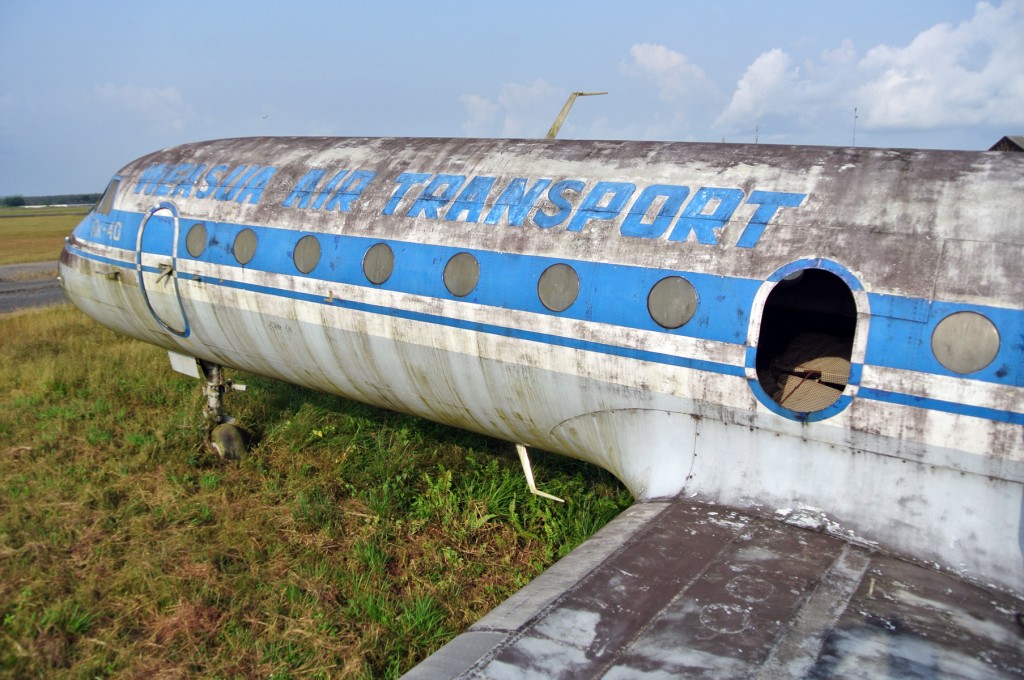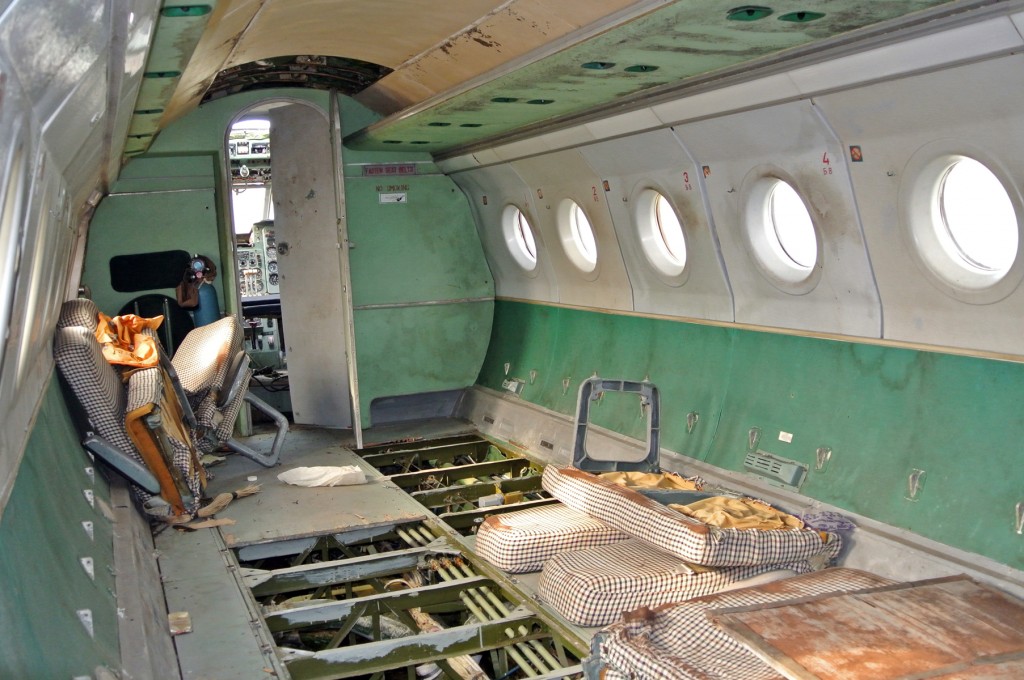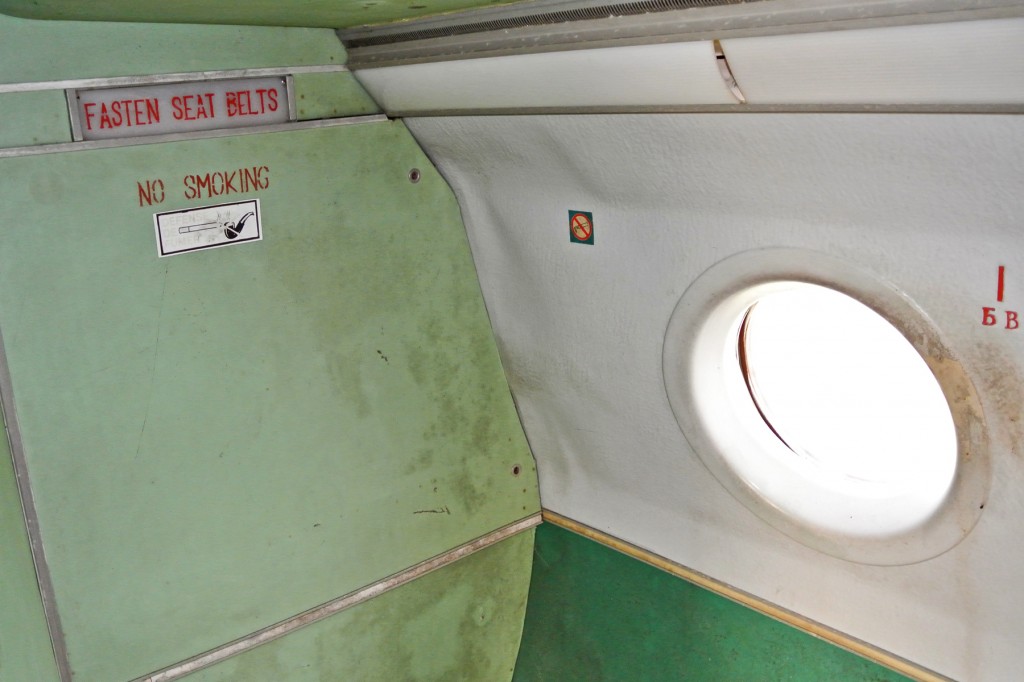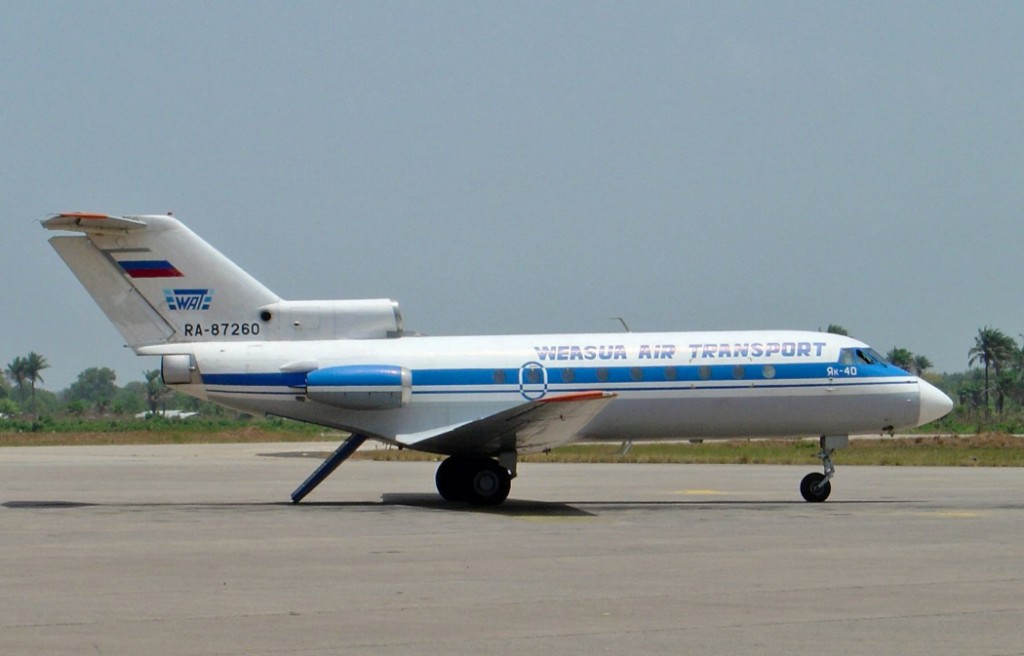Yak Hunting in Liberia
PHOTOS AND STORY BY PATRICK SMITH
POSSIBLY THIS IS ONE OF THOSE THINGS only an aerophile can understand, but there’s something so fascinating, even enchanting, about old abandoned airplanes.
Entire books have been written about them — field guides, you could say — chronicling the whereabouts of this or that crashed, abandoned, or otherwise derelict airliner. You find them crashed in forests, mothballed in the desert, and tucked away in weedy corners of third-world airports: antique propliners like Constellations and DC-6s; sun-bleached 707s and DC-8s; retired Soviet Tupolevs. The jetliner boneyards in California and Arizona receive hundreds of requests annually from airliner geeks eager to explore their inventories.
For some of us, poring over some discarded old plane is even more exciting than exploring a still-flying one.
We see these planes as monuments, perhaps? To the men and women who flew them, to the passengers who rode aboard them — and most extraordinary of all, to the the places these planes have been. The difference between the peculiar grandeur of an old abandoned building, for instance, and that of an old abandoned airplane, is that the building existed only in a fixed location. Airplanes, they’ve been everywhere.
I remember, during my visit to the boneyard at Mojave a few years back, looking up at a retired Boeing 747, soon destined for the scrapper. The very same jumbo jet, I later learned, once made London and Honolulu runs for PeopleExpress. Before that, it wore the name “City of Adelaide” for Qantas. I thought of all the far-flung places this elegant machine must have visited in its nearly three decades of flying, from Newark to New Delhi, Bangkok to Buenos Aires. With the same sort of melancholy one feels when remembering an elderly relative in younger, happier times, I imagined this same 747, years ago, whirling in over Hong Kong harbor, ascending over Cape Town at dusk.
Of course, the real stories don’t belong to the planes themselves, but to the people they carried – from sheiks and dignitaries, to millions upon millions of vacationers and tourists. Looking up at the forlorn hulk of that 747, I realized that with every takeoff the plane made, up 450 people were borne aloft with it. Over a 30 year-career, that’s about five million stories. Its rows of empty chairs were like the rings of an ancient tree.
This past Christmas I had the chance to visit an abandoned Yak-40 at Roberts Field — the airport serving Monrovia, Liberia, in West Africa.
The Yakovlev Yak-40 was a tiny three-engined jet made in the Soviet Union. It carried about 30 people. Almost a thousand Yak-40s were built between 1966 and 1978. This was a true “regional jet” some three decades before the term ever existed. A few are still in service.
I’d noticed the derelict Yak on earlier visits to Roberts, but never had the opportunity to wander over and explore. This time, in the company of an airport worker and his van, I was able to make the trip.
The plane wears a Russian registration and the markings of something called Weasua Air Transport, a tiny Liberian carrier that, according to Google and the database at Airliner.net, was shut down by regulators in 2006. Apparently Weasua never had more than two or three aircraft at a time — one of which crashed — and was once a member the European Union’s safety blacklist. The blue markings borrow from the old Aeroflot livery, and I imagine the jet once flew for Aeroflot, as most Yak-40s did.
Exactly how long it’s been sitting here, and other details of its past, are unknown. It’s doubtful this old jet did much “whirling in over Hong Kong harbor.” Trundling through an ice-fog over Smolensk is more like it. Nonetheless, these mysteries make the plane that much more interesting.
I love the Soviet-style oval doors.
It was best to tread carefully on the walk from the overwing entry door to the cockpit. The cabin floor is mostly torn up, meaning one slip and you’re up to your knees in metal fuselage ribbing, assorted machinery, and greasy water. Up front, the pilots’ overhead escape hatch is missing, permanently exposing the interior to Liberia’s heat and drenching rains. Thus the cabin has become a sort of tropical terrarium, with about eight inches of stagnant green water between the floorboards and the bottom of the fuselage. I can’t imagine how many mosquitos — and who knows what all else — breed in here.
The NO SMOKING sign features a pipe. Note also the Cyrillic seat designator.
The cockpit is a baffling array of early generation engine gauges and instruments. I couldn’t tell you what half of these switches and dials might be for. The placards and labels are in Russian.
In the weeds nearby are hundreds of barrels of heavy black liquid that appears to be tar — much of which has leaked into ankle-deep slicks.
I was able to unearth this shot of the very same plane — note the registration, RA-87260 — in happier times, seen in Sierra Leone in 2004. (Photo courtesy of Ali Hammoud.)
RELATED STORIES:
IMAGES FROM LIBERIA. PHOTOS FROM ROBERTS FIELD AND BEYOND.
LETTER FROM MOJAVE. THE DEEPER MEANINGS OF AN AIRPORT GRAVEYARD.














Leave a Comment
Maximum 1500 characters. Watch your spelling and grammar. Poorly written posts will be deleted!
34 Responses to “Yak Hunting in Liberia”
You are viewing newest comments first. Click to reverse order
I’ve only recently discovered your excellent site and had to smile when I read this article. I recall a flight from Accra to Monrovia in, If not this a/c then certainly its sister. The fun started when I was booking the ticket at what for the time was a totally outrageous price. When I asked why I was told that if I was crazy enough to go there (there were troubles at the time) then I was crazy enough to pay the price!
There were perhaps eight passengers on the flight with one flight attendant in the cabin. In flight catering was one polystyrene cup (for everyone) and a bottle of water which was passed round. The cup being wiped before being passed on to the next person.
The corkscrew descent into MLW was not prewarned to us passengers but served to put us in a perfect frame of mind for the fun ahead once we landed. A few days later and departing on the same a/c at a climb rate just as scary as the descent rate I will always recall one of my fellow passengers looking out the window, turning back to his fellow passenger with a ” Thank f*** were out of there”
Ah memories!
Do you think it is possible to restore the plane to flying condition? Maybe with modifications? Or is it just too broken?
Not a chance. The plane is far, far beyond any chance of becoming airworthy again.
There are other Yak-40s out there still flying, however.
Hello PATRICK, do you know if this particular YAK is available for sale? I’d love to keep a museum of old planes
Our technological advancements in this century are pretty impressive!
Great article, thank for sharing!
Speaking of “Looking for Yak’s in Liberia. I have a photo from an old magazine of a Liberia Air Transport. No registration number shown. Anybody know of this airline or have a photo of it?
Thanks
What a great post, Patrick. I am one of those who loves to see and climb through old abandoned aircraft as well. The group that used to be the Confederate Air Force had some old aircraft sitting in a clump in southern Texas sever (many) years ago and I was able to climb through them. I would love to get out to the desert and walk through the aircraft parked out there but would probably end up crying at so many regal, once useful machines just sitting there.
I worked as GM for Weasua during the period 1991/95 during and after the Liberian civil war.
Interesting story about this Yak 40 and how it has ended up.
Very cool Patrick-
I echo everyone’s comments here.
I ride/train on my road bike around Bedford/Concord and miss my routine of swooping down into Hanscom Field and geeking out next to that old NW 727-100 parked behind the fence at the former NE Aero Tech hangar. That was so cool, because you could get right next to it.
Do you know if it got scrapped or just moved somewhere else- maybe indoors?
(I grew up in MSP with many NW 727 pilot family friends)
…retired classics are always fascinating to me
Having done a lot of air travel to third-world countries in the mid-60s I have had rides on several airlines and aircraft that are no longer existing – C-133, DC-8, Comet IV and Caravelle come to mind.
I also have seen many relics pushed off to the side in various locations, but the one that comes to mind here is, upon my first arrival in Recife, Brazil in 1966 (on that Caravelle) I saw four parked B-17s. My first thought was, “retired, waiting for salvage”, until later that week I was in the Base Commander’s office. Behind his desk was a large photo of four B-17s flying in formation.
I recall about 10 years or so ago driving along the beach on Barbados and seeing a Concorde rusting away in a field. I think it’s been somewhat restored and lives in a museum down there….
There is something so cool and mysterious about old abandoned planes…there’s one near Reykjavik I want to see in person. Love the Flickr photos and you were an extremely cute kid.
[…] stories: YAK HUNTING IN LIBERIA DEEPER MEANINGS OF AN AIRPORT […]
Patrick, have you seen the increasingly less decrepit 747 RA001 in Seattle? It’s the first 747. It sat neglected for a long time, but it’s now being restored.
Love the article and finding old planes. My two faves are:
–finding a B25 on a Michigan airfield. Bottom hatch was open so we high-schoolers boosted ourselves up, played a bit and grabbed a manual before escaping to our car.
–Much later, on way to honeymoon on St Barts, the plane stops at St Martins, before catching a de Havilland Dash 7 to our destination.
Waiting for that flight, I found a de Havilland Dragon Rapide rotting in the weeds near the terminal.
Would have been cool to track down its papers… but I had other things on me mind at the time.
Best!
Weasua Air Transport has been implicated in arms transport and may have had ties to international arms dealer Viktor Bout.
Very interesting article.
Patrick,
Were you able to recover the cockpit voice recorder and flight recorder from the Yak? If so, what did they reveal?
Generally, what happens to them when planes are boneyarded in the US? Are they boneyarded separately? Is the data and voice recordings archived? Can I buy one on ebay?
Just a heads up: the Flickr link at the end of the post is misdirected. (I found the right page by searching flickr, but I wasn’t sure if I should provide the URL here—basically, tho, it should be forward slash-‘photos’-forward slash-‘globetrodden’-forward slash-‘sets’.)
Oh, and: awesome photos!
Fixed: http://www.flickr.com/globetrodden/sets
Fantastic article! @ Lee: it’s not about bad engines (they can be rebuilt or replaced ad infinitum), it’s about “number of cycles” (takeoffs/landings). After a certain number of times of being pressurized/depressurized, metal fatigue sets in, and the aircraft is no longer safe. Also, outdated economics play a part. There comes a time when older, less-efficient aircraft cannot make money.
Great story! Reminded me of my days in ’05 in the boonies of Sudan. I’d seen a few disused YAK 42s in Khartoum Airport and upon inquiries was astonished by the measly selling price quoted, of USD 50k. I’m sure they had no entrails or other useful parts. Those were the days when I made inquiries about aviation and particular models on a public group and got reported to the FBI by a retired USAF pilot. I thought that paranoid and OTT but such is life for a colored cove with a strange name!
[…] was a travel day, I figured an article about airplanes was appropriate… and so, here’s an article about Yak Hunting. Specifically, an article about hunting down the remains of a Yakovlev Yak-40 in Liberia and […]
Patrick, just loved this story because I’m more fascinated by old derelict planes than brand spanking new ones. My favorite picture of my very young son is one taken at Burbank Airport years ago in a very old, deserted DC3. He’s in the pilot seat and looks like an old pro!
Wish I could send it to you but there’s no place here to attach photos that I can find. If you’d like to see this picture of old and new, give me an email and I’ll forward it on to you! Thanks,
John
I’m not an airline maintenance director and never played one on TV, but at what point does an airline executive point to a perfectly operable and maintained aircraft and say, “Park it in the weeds and let it rot”? This is never done with antique cars, and as anyone who watches Hollywood movies can tell you, it’s never done with antique trucks, buses, streetcars, etc. You can go to airshows and see aircraft from every era lovingly restored and maintained. So why park one and leave it? Because it needs an engine overhaul? Why not overhaul the engine?
Lee, if an airplane and/or its engines are due for a major overhaul there comes a time when that task costs more than the airplane is worth. Actual value or depreciated value – whatever
The airline will try to sell it, but if no one wants it then it will be ferried to a boneyard and sold for its scrap value. The airframe will be stripped for usable res and then cut up for scrap.
Some airlines will just scrap the airplane at their own facility. It ain’t pretty but so it goes.
oops – “spares” not “res”
“Actual value or depreciated value” is an important number if you want to sell something or do your taxes. It is the way accountants see things. However, if you don’t want to sell something, and just need whatever function the item performs, it is not too important.
What I do is simple. I compare the price of repairs to the price of replacement.
For example: if a repair costs $500 and the monthly cost of a replacement is $500, all you need is one month of use to break even. Every future month is $500 extra in your pocket. The monthly cost of the replacement goes on and on.
The same kind of thinking should be applied to “gas mileage”. To buy a new car ONLY because it gets better MPGs than your old one is throwing money away.
There will be more repairs needed on old equipment, and new gear has new features, but you can get an awful lot of use, for an awful lot less money, by fixing – until you no longer have a reasonable option. As Scott says below, “There comes a time when older, less-efficient aircraft cannot make money.”
Maybe that’s one of the reasons that the Douglas DC-3, the DeHaviland Beaver, the Norseman, and other old birds, are still flying and producing profits.
[…] Join me on a photo essay from Roberts Field, Liberia, where we visit a decomposing Yak-40…. https://askthepilot.com/yak-hunting-in-liberia/ "…We see these planes as monuments, perhaps? To the men and women who flew them, to the […]
Excellent story, very well written, wonderful photos. Shows planning and effort, like all your columns.
Very interesting story Patrick. Like you, I enjoy the poetry of these flying machines laid at rest, which trigger the imagination. I actually flew in a Yak 40, in Syria in 2010, before the civil war, on a Syrian Arab Airlines domestic flight between Damascus and Lattakia. It was a short flight, which was quite as well because comfort is pointedly absent in these planes, a mark of the Soviet era. Seats are hardly better than padded kitchen chairs, it may have been designed for 30 passengers but feels cramped with 12, and with the three jet engines it is quite noisy. Why they would need three engines on such a small plane anyway, I don’t know. Thinking back about it, it was a fun experience, but thankfully an isolated one.
I will never forget my one flight ten years ago on a Yak-40 from Kyiv to Uzhgorod. It is about the size of a KingAir, and has gotta be the slowest pure jet in the world. It took two hours, so we could not have cruised much more than 250 KTAS (Are we there yet?). A SAAB 209 could outrun it. Like a lot of post-Soviet infrastructure, it was substantial and well maintained, but felt like it was from another era.
Those who complain about domestic air service in the US should try domestic flights in Eastern Europe…
Old airliners and old pilots. Used to watch a man, now deceased, take his Cessna 140 out to tool around. He’d been with Pan American in the Halaby days and had been one of the first captains to get a 747. Guys at the nearby flight school would come to him to get tailwheel endorsement and get a good dose of flight principles as well. The 140 is in new paint and still not far from here. And it, too, probably has tales it could tell.
Really interesting post. Thanks I love looking up the rego numbers of planes I fly on. Here in Asia they are often 2nd or 3rd hand and it really is fascinating to image the plane I’m on from SIN to CGK was doing runs across Europe or the U.S.